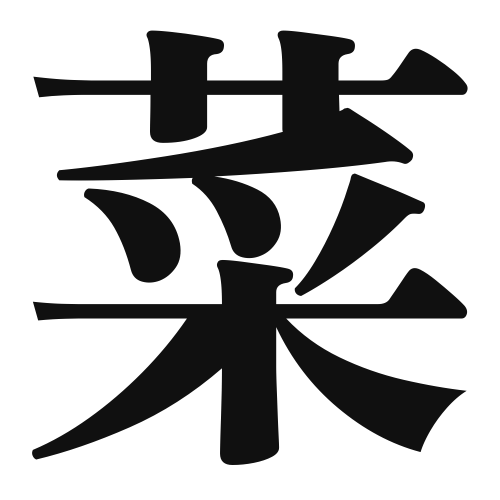1. Overview of Meaning
The kanji “菜” (pronounced “nai” or “sai”) primarily means “vegetable” or “greens.” It refers to edible plants, particularly leafy vegetables used in cooking.
2. Formation and Radical
Formation of the Kanji: The kanji “菜” is a compound character (会意文字) that combines elements to convey its meaning. It consists of the radical for “vegetable” (艹) on top, which indicates its relation to plants, and the character “采” (sai), which means “to pick” or “to gather.”
Radical: The radical of “菜” is 艹 (the grass radical), which is commonly found in kanji related to plants and vegetation.
3. Examples of Usage
Common Words and Phrases: Some frequently used words that include “菜” are:
- 野菜 (やさい, yasai) – vegetables
- 菜食 (さいしょく, saishoku) – vegetarian diet
- 菜園 (さいえん, saien) – vegetable garden
Example Sentences in Daily Conversation:
- 今夜の夕食には新鮮な野菜を使います。
(I will use fresh vegetables for dinner tonight.) - 彼は菜食主義者です。
(He is a vegetarian.)
4. Synonyms and Antonyms
Similar Kanji: A similar kanji is “野” (や, ya), which means “field” or “wild.” While “菜” refers specifically to edible plants, “野” encompasses a broader range of natural landscapes.
Antonyms: An antonym could be “肉” (にく, niku), which means “meat.” While “菜” refers to plant-based foods, “肉” refers to animal-based foods.
5. Cultural and Historical Background
Relation to Japanese Culture: In Japan, vegetables play a significant role in traditional cuisine, such as in dishes like “sushi” and “tempura.” The appreciation for seasonal vegetables is deeply rooted in Japanese culinary practices.
Proverbs and Idioms: One common saying is “菜の花が咲く” (なばながさく, nabana ga saku), which means “the rapeseed flowers bloom,” symbolizing the arrival of spring and the beauty of nature.
